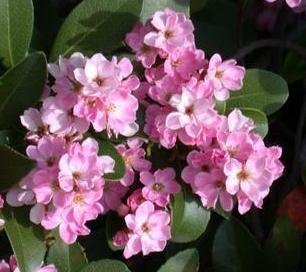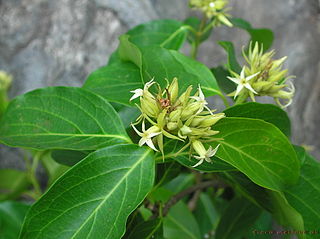
Adonis is a genus of about 20–30 species of flowering plants of the crowfoot family, Ranunculaceae, native to Europe and Asia.

Pachypodium baronii, the Madagascar palm or bontaka, is a flowering plant in the family Apocynaceae. It has the habit of a robust shrub with a spherical or bottle-shaped trunk. It has several cylindrical branches at the top.
Pachypodium bicolor is a species of plant in the family Apocynaceae.

Pachypodium brevicaule is a species of plant that belongs to the family Apocynaceae.

Nepenthes rigidifolia is a critically endangered tropical pitcher plant endemic to Sumatra, where it grows at elevations of 1000–1600 m above sea level.

Rhaphiolepis indica, the Indian hawthorn, India hawthorn or Hong Kong hawthorn is an evergreen shrub in the family Rosaceae.

Cissampelos pareira (velvetleaf) is a species of flowering plant in the family Menispermaceae.

Solanum evolvuloides is a species of Solanum, which was first described in 2011 by Giacomin & Stehmann. Solanum evolvuloides belongs to section Gonatotrichum, a small group assigned to the Brevantherum clade of the genus Solanum. It resembles Solanum turneroides Chodat, sharing with it heterandry, and Solanum parcistrigosum Bitter, with which it shares a similar habit and pubescence. Despite these similarities, the species can be recognized by its ovate-elliptic to cordiform leaf shape and more membranaceous leaf texture than the other species in the section, and stem, inflorescence axes, and calyx vestiture mainly composed of glandular hairs. Solanum evolvuloides is known to occur only in southeastern of Bahia state, Brazil, and in a preliminary assessment of the International Union for Conservation of Nature (IUCN) criteria can be considered a threatened species.

Eucryphia milliganii, also known as the dwarf leatherwood, is a shrub or small tree endemic to areas of Tasmania. It grows in western and southern Tasmania, where it is most commonly found in alpine and sub-alpine heath areas. It is the sister species of the popular horticulture plant Eucryphia lucida also known as Leatherwood..
Adenorandia is a monotypic genus of flowering plants in the family Rubiaceae. It was described by Vermoesen in 1922. The genus contains only one species, viz. Adenorandia kalbreyeri, which is found from west-central tropical Africa.
The micrantha is a wild citrus from the papeda group, native to southern Philippines, particularly islands of Cebu and Bohol. Two varieties are recognized: small-flowered papeda, locally known as biasong, and small-fruited papeda or samuyao.

Aganosma cymosa is a liana that can grow up to 10 m (33 ft) in length, pale brownish tomentose. Leaf-stalks are 1–2 cm (0.4–0.8 in), leaf blade broadly ovate or orbicular, 5–16 cm (2.0–6.3 in) by 4–12 cm (1.6–4.7 in), base rounded or obtuse, apex acuminate or obtuse, rarely retuse, lateral veins eight to ten pairs. Flowers are borne in many-flowered clusters at branch ends, which are carried on stalks up to 6 cm (2.4 in). Bracts and bracteoles are very narrowly elliptic, about 1 cm (0.4 in) long. Flower-stalks are about 5 mm (0.2 in). Calyx with several glands inside margin of sepals; sepals very narrowly elliptic, about 1 cm (0.4 in), pubescent on both surfaces. Flowers are white, minutely tomentose outside, glabrous at throat; tube shorter than sepals, 6–7 mm (0.2–0.3 in); lobes oblong, as long as tube. Disc longer than ovary. Ovary pubescent at apex. Follicles 2, cylindric, to 30 cm (12 in) by 0.8–1.2 cm (0.3–0.5 in), yellow hirsute. Seeds oblong, 1–2 cm (0.4–0.8 in) by about 5 mm (0.2 in), coma 2–4.5 cm (0.8–1.8 in). It is native to China, Bangladesh, India, Sri Lanka, and Indochina.

Karomia speciosa is an African deciduous large shrub or bushy tree up to 7 m, and relocated to the family Lamiaceae from Verbenaceae. It is one of 9 species in the genus Karomia, a genus containing species previously classified in Holmskioldia, and is closely related to Clerodendrum. The only remaining species in the genus is Holmskioldia sanguinea, occurring in the foothills of the Himalayas.

Cinnamomum kanehirae, also known as small-flowered camphor tree, or stout camphor tree, is a tree within the genus Cinnamomum of the family Lauraceae endemic to Taiwan.

Clematis hedysarifolia is a liana, endemic to peninsular India, belonging to the buttercup family (Ranunculaceae). It was described by Augustin Pyramus de Candolle and published in Regni Vegetabilis Systema Naturale 1: 148, in 1817.
Passiflora quetzal is a species of flowering plant native to Mexico and Guatemala described in 2004. It is named after the quetzal, which inhabits the area.

Salix breviserrata is a species of willow belonging to the family Salicaceae. It is found in southern Europe in the Alps, and in the Iberian Peninsula in the Cantabrian Mountains, especially in the Picos de Europa, Somiedo, and the Sierra and Valle del Híjar.
Salix alatavica is a small shrub from the genus of willow (Salix). It is native to mountainous slopes in Asia, in Kazakhstan, southern Russia, Mongolia, and northern China.
Salix driophila is a shrub from the genus of willow (Salix). The natural range of the species is in China.
Gutenbergia rueppellii is an African species of flowering plant in the family Asteraceae.














